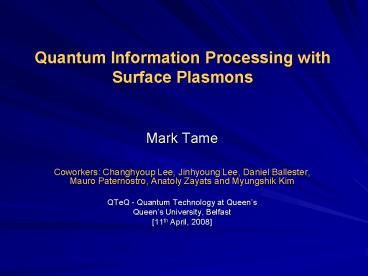Mark Tame - PowerPoint PPT Presentation
1 / 22
Title:
Mark Tame
Description:
Mark Tame. Coworkers: Changhyoup Lee, Jinhyoung Lee, Daniel ... (hydrodynamics. important) l. Introduction Length scales. dm decay of SPP into metal ... – PowerPoint PPT presentation
Number of Views:89
Avg rating:3.0/5.0
Title: Mark Tame
1
Quantum Information Processing with Surface
Plasmons
- Mark Tame
- Coworkers Changhyoup Lee, Jinhyoung Lee, Daniel
Ballester, Mauro Paternostro, Anatoly Zayats and
Myungshik Kim - QTeQ - Quantum Technology at Queens
- Queens University, Belfast
- 11th April, 2008
2
Overview
- Introduction - What are Surface Plasmons?
- Applications - Nano-plasmonics and QIP
- Current Achievements - Studies related to QIP
- Problems to be Solved
3
Overview
- Introduction - What are Surface Plasmons?
- Applications - Nano-plasmonics and QIP
- Current Achievements - Studies related to QIP
- Problems to be Solved
4
Introduction a Brief History
Robert Wood observes power loss in a spectroscopy
experiment for light reflected off metal grating
surfaces
1902
Jonathan Zenneck unknowingly introduces
mathematical description of surface plasma
waves, while studying radio waves.
1907
Ugo Fano produces the first consistent
explanation of Woods observed power loss
surface plasma waves are properly introduced.
1947
-1956 David Pines introduces quantized plasma
oscillations in bulk metals, calling them
plasmons. -1957 Rufus Ritchie studies
electron energy losses in thin films first
theoretical description of surface
plasmons. -1958 John Hopfield introduces the
term polariton for the coupled oscillation of
bound electrons and light in transparent media.
1956- 1958
1968
Andreas Otto, Erich Kretschmann and Heinz Raether
present methods for the optical excitation of
surface plasmon polaritons on metal films.
This is a major advancement, making experiments
on surface plasmon polaritons easily accessible
to many researchers (see bar chart).
2002
The quantum optics and quantum information
communities begin to develop a keen interest in
using surface plasmon polaritons for QIP
purposes
Now
5
Introduction What are Surface Plasmons?
Photon
SPP
Barnes, Dereux and Ebbesen, Nature 824, 242 (2003)
(for air eair1)
Johnson and Christy, PRB 6, 4370 (1972)
6
Introduction What are Surface Plasmons?
Q Whats the difference between a surface
plasmon and a surface plasmon polariton?
Photon curve
SPP curve
Plasmon like (hydrodynamics important)
Photon like (retardation important)
l
7
Introduction Length scales
Highly confined
dm decay of SPP into metal dd decay of SPP
into air/dielectric l a chosen wavelength for
the SPP dSP propagation decay length of SPP
8
Introduction excitation methods
Otto (1968)
Kretschmann-Raether (1968)
Zayats, Smolyaninov and Maradudin, Phys. Rep.
408, 131 (2005)
SNOM (1989)
Diffraction grating (1974)
Mode-matching possible
9
Introduction other modes in a metal
TO Bulk Photon curve
LO Bulk Plasmon curve
-Surface phonon polaritons -Bulk phonon polaritons
Elson and Ritchie, PRB 4, 4129 (1971)
10
Introduction quantization
Surface plasma waves
Quantize
Surface plasmon polaritons
1st retarded quantization Elson and Ritchie, PRB
4, 4129 (1971)
11
Overview
- Introduction - What are Surface Plasmons?
- Applications - Nano-plasmonics and QIP
- Current Achievements - Studies related to QIP
- Problems to be Solved
12
Applications
General
- Electrochemistry
- -Knoll, Ann. Rev. Phys. Chem 49, 569 (1998)
- Biosensing
- -Malmqvist, Nature 361, 186 (1993)
- Scanning tunneling microscopy
- -Berndt et al., PRL 67, 3796 (1991)
- Miniature photonic circuits (sub-wavelength)
- -Nomura et al., APL 86, 181108
13
Applications
QIP
Due to tight field confinement, non-linear
effects can be significantly larger than
standard fibre-based solutions
Quantum Computing
- Non-linear sign gate required in KLM scheme,
- -Knill, Laflamme and Milburn, Nature 409, 46
(1998)
- Single qubit rotations in coherent state QIP,
- -Jeong and Kim, PRA 65, 042305 (2002)
- -Enk and Hirota, PRA 64, 022313 (2001)
- -Ralph, Munro and Milburn, quant-ph/0110115
QIP in general
- Generating optical coherent cat states,
- -Yurke and Stoler, PRL 57, 13 (1986)
- Complete set of Bell discriminators (i.e. full
- Bell measurement)
- -Lutkenhaus, Calsamiglia and Suominen, PRA 59,
3295 (1999)
- Photon blockade
- -Imamoglu, PRL (2001), Paternostro, Kim and Ham,
JMO (2003)
- Various schemes based on EIT
- -Imamoglu, Beausoleil, Paternostro, Petrosyan,
Ottaviani...
- Single photon transistor,
- -Chang et al., Nature Physics 3, 807 (2007)
14
Overview
- Introduction - What are Surface Plasmons?
- Applications - Nano-plasmonics and QIP
- Current Achievements - Studies related to QIP
- Problems to be Solved
15
Current Achievements
Nature 418, 304 (2002)
Theory Moreno et al. PRL 92, 236801 (2004)
16
Current Achievements
Fasel et al. PRL 94, 110501 (2005)
Theory Fasel et al. NJP 8, 13 (2006)
17
Current Achievements
Akimov et al. Nature 450, 402 (2007)
Theory Akimov et al. PRL 97, 053002 (2006)
18
Current Achievements
Theory Chang et al. Nature Physics 3, 807 (2007)
Coupling method
19
Overview
- Introduction - What are Surface Plasmons?
- Applications - Nano-plasmonics and QIP
- Current Achievements - Studies related to QIP
- Problems to be Solved
20
Problems to be solved
- Reaching higher transfer efficiencies (in/out) in
experiments - (max 27 - Akimov et al. Nature 450, 402 (2007))
- Satisfactory theory of Photon-SPP coupling
- at the quantum level
- Understanding nonlinear SPP effects and how to
- take advantage
21
Overview
- Introduction - What are Surface Plasmons?
- Applications - Nano-plasmonics and QIP
- Current Achievements - Studies related to QIP
- Problems to be Solved
22
(No Transcript)












![READ [PDF] Billy Weird (Billy Weird Series) PowerPoint PPT Presentation](https://s3.amazonaws.com/images.powershow.com/10046244.th0.jpg?_=20240603071)
![Aphrodite Muse, tell me the deeds of golden Aphrodite the Cyprian, who stirs up sweet passion in the gods and subdues the tribes of mortal men and birds that fly in air and all the many creatures [5] that the dry land rears, and all that the sea: all PowerPoint PPT Presentation](https://s3.amazonaws.com/images.powershow.com/P1246341518xkAXF.th0.jpg?_=202010060312)

















